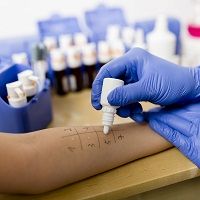Article
Study Shows Potential Gender Difference in Allergic Reactions
Author(s):
Allergists have long known that women are more likely than men to suffer severe allergic reactions such as anaphylaxis, but a new study may finally explain why.

Allergists have long known that women are more likely than men to suffer severe allergic reactions such as anaphylaxis, but a new study may finally explain why.
Researchers from the National Institute of Allergy and Infectious Diseases (NIAID) began by using histamine — along with either Immunoglobulin E or Immunoglobulin G — to induce anaphylaxis in mice.
They then monitored each animal’s reaction and noted that female mice, like human women, fared worse than their male counterparts. Their symptoms grew more severe and lasted longer.
Further testing revealed that estradiol inside the female mice stimulated the production of endothelial nitric oxide synthase (eNOS) and then made the enzyme more active when allergic reactions took place.
The researchers knew that eNOS can worsen anaphylaxis by producing nitric oxide, which, in turn, causes blood pressure to drop, allows fluid to leak into tissues and creates swelling. They decided, therefore, to block the enzyme’s activity, induce anaphylaxis again and look for changes.
The experiment produced a striking result: all the gaps between the male and female mice disappeared.
“Blockage of NOS activity with the inhibitor L-NG-nitroarginine methyl ester or genetic eNOS deficiency abolished the sex-related differences,” the study authors wrote in the Journal of Allergy and Clinical Immunology.
The researchers also reduced reaction severity by going straight to the apparent source of the problem.
“The enhanced severity of anaphylaxis in female mice was eliminated after pretreatment with an estrogen receptor antagonist or ovariectomy but restored after administration of estradiol in ovariectomized mice, demonstrating that the sex-specific differences are due to the female steroid estradiol. Estrogen did not affect mast cell responsiveness or anaphylaxis onset. Instead, it
increased tissue expression of eNOS,” they wrote.
The study authors believe their work provides significant new insight into the mechanisms of anaphylaxis and that it may someday yield practical benefits, either in the form of new treatments for women or, at the very least, more accurate understanding about which women face the greatest risks.
That said, only further research can say how these findings apply to humans, if they apply at all, and that research will be difficult to conduct. Doctors cannot induce a life-threating reaction such as anaphylaxis in human subjects, so they have no way to test different hypotheses and different treatments one after the other.
Until researchers find some way to get definitive answers, the mouse data may prove helpful to allergists and emergency room doctors when they are dealing with human patients, according to
Dean Metcalfe, the head of NIAID’s Laboratory of Allergic Diseases.
For example, the mouse study suggests that women who are of childbearing age and those who use hormone-replacement therapy after menopause face more danger from anaphylaxis than other women with allergies.
Metcalfe, who is also an author of the new study, also believes that women who take a performance supplement called L-arginine may be at particular risk because it increases the production of nitric oxide.
On the other hand, the mouse study suggests that women with low levels of estrogen should face relatively less risk of anaphylaxis, and there are many studies that suggest this may be the case.
Prepubescent girls suffer from allergies less that prepubescent boys do. It is only toward the end of adolescence that women begin to fare worse than men.



